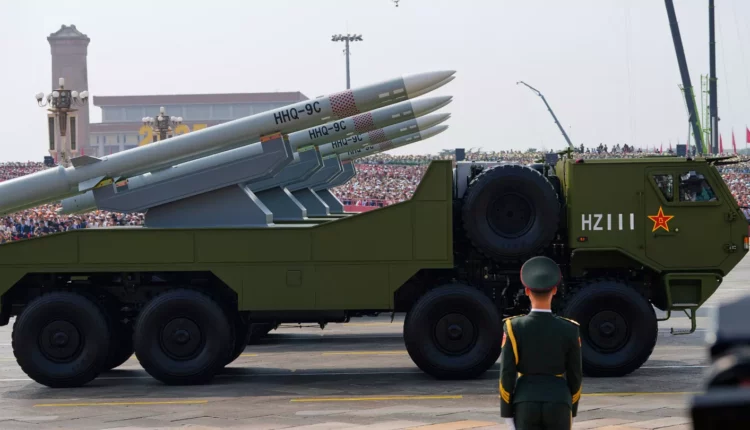©2021 Reporters Post24. All Rights Reserved.
China has deployed a working prototype of a global defence system similar to the United States’ proposed Golden Dome, while hailing a breakthrough in data processing technology for worldwide threat management, according to scientists involved in the project.
Although the “distributed early warning detection big data platform” is still in its early stages of development, it can simultaneously monitor a thousand missiles fired at China from anywhere in the world, according to the developers.
By leveraging diverse sensors in space, the ocean, the air and on the ground, the system identifies and analyses potential threats, acquiring critical information in real time, such as flight trajectories, weapon types and whether they are true warheads or decoys to guide interception systems.
The team says the system can integrate data from different types of military platforms – developed by various suppliers, deployed in different regions and over different time periods – and transmit and analyse massive volumes of data at high speed through highly secure but bandwidth-limited military networks, even when subject to interference or disruption.
It is the first missile defence system known to reach planet-wide coverage.
The US’ missile defence system is divided into separate regional segments. In May, President Donald Trump proposed the Golden Dome initiative to break down geographical barriers and achieve global information sharing.
But to date, no fundamental architectural plan has been established. Neither the Pentagon nor defence contractors have proposed a feasible solution for managing data flows, or reached consensus on how the system will be implemented.
Some defence technology experts say the Golden Dome might be another instance in which “the US has an idea but China brings it to life”.
Due to deindustrialisation, America’s ability to develop and produce new weapons was declining at an unexpected pace, they said, with programmes such as hypersonic missiles, high-powered laser weapons, sixth-generation fighters and electromagnetic catapults for carrier-based stealth aircraft all facing significant delays in the US while China was advancing these technologies.
According to the project team led by senior engineer Li Xudong at the Nanjing Research Institute of Electronics Technology, China’s largest R&D hub for defence electronic system engineering, the prototype “distributed early warning detection big data platform” had been developed, tested and deployed by the People’s Liberation Army (PLA).
The researchers said the system was designed to overcome the long-standing challenges of integrating fragmented, heterogeneous data sources from radar, satellite, optical and electronic reconnaissance systems across space, air, sea and land.
“The prototype system can achieve distributed parallel scheduling of up to 1,000 data processing tasks across nodes,” Li’s team wrote in a peer-reviewed paper published in the Chinese journal, Modern Radar, on September 2.
“By uniformly collecting and integrating data products from top-level nodes of existing early warning and detection systems – such as comprehensive target tracking data, target detection images, launch alerts, incoming threat warnings and target identification results – it has realised unified aggregation, governance and shared application of data at the global early warning situational awareness level,” the paper said.
“Currently, the prototype system has been tested across multiple early warning and detection system nodes, achieving unified collection, processing, integration and analysis of fragmented, isolated and multi-format early warning and detection data.
“The resulting data products can be centrally published, significantly enhancing the comprehensive management capabilities” of the PLA headquarters, added Li and his colleagues.
In contrast, the US Golden Dome programme, which is aimed at creating an integrated, AI-enabled missile defence network spanning land, sea, air and space, has yet to establish a clear technical architecture.
US Space Force General Michael Guetlein, the programme’s lead, acknowledged that the definitive design of an “objective architecture” was far from settled.
“Everyone who’s telling you they think they know, do not know, including me,” he said at an industrial event in July.
According to a Spacenews.com report on August 2, US industry has warned that the Golden Dome’s biggest challenge is not missiles, but data flow.
Dan Knight, vice-president of sensors and data integration at national security tech firm Arcfield, said in a Spacenews panel discussion that while the Golden Dome was intended to defend North America, it must also support “tactically forward units” and adapt to overseas conflicts involving drones or short-range ballistic missiles.
And this, together with issues such as whether it must include systems operated by allied forces or allow AI access to sensitive information, underscore data management as a central issue for the Golden Dome project.
“We have the information, or we have the data that we need. It’s just not in the right places,” Knight said, according to Spacenews. “It’s going to be essential for us to architect what is currently in place through model-based systems engineering, and then build out on that.”
China’s platform operates on a “physically dispersed, logically unified” architecture. It integrates data across multiple domains without requiring legacy systems to be overhauled, according to Li’s team.
It employs a wide range of technologies for data ingestion, storage and real-time processing. A key innovation is the use of QUIC (Quick UDP Internet Connections), a next-generation transport protocol for reliable, high-speed data transmission across nodes, even under conditions of network congestion or intermittent connectivity.
The data collected by the system would be used for AI training, according to the researchers, who said the prototype was not perfect. They expected to improve and scale up the system. — SOUTH CHINA MORNING POST


